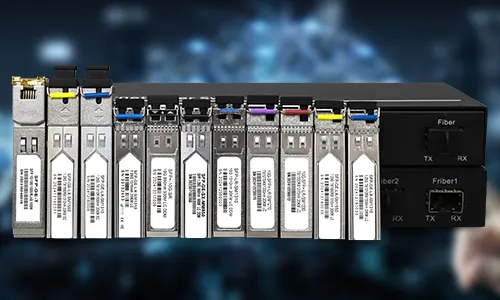OLT (Optical Line Terminal) and switches are critical devices in optical communication networks, but their optical modules differ significantly in types, functionalities, and applications. Below is a detailed breakdown:
I. Types of OLT Optical Modules
OLT is the core device in PON (Passive Optical Network) systems, connecting carrier backbone networks to user-end ONUs (Optical Network Units). OLT modules must support PON protocols and long-distance, high-power transmission. Common types include:
1. By PON Technology
- GPON Modules
- Standard: ITU-T G.984
- Speed: Downstream 2.488Gbps, Upstream 1.244Gbps
- Wavelength: Downstream 1490nm, Upstream 1310nm
- Distance: 20–60 km, supports split ratios up to 1:64 or 1:128.
- EPON Modules
- Standard: IEEE 802.3ah
- Speed: Symmetric 1.25Gbps
- Wavelength: Downstream 1490nm, Upstream 1310nm
- Use Case: Cost-sensitive access networks.
- XG-PON/XGS-PON Modules
- Standard: ITU-T G.987/G.9807
- Speed: XG-PON (10G down / 2.5G up), XGS-PON (symmetric 10G)
- Wavelength: Downstream 1577nm, Upstream 1270nm
- Feature: Coexists with GPON via WDM.
- NG-PON2 Modules
- Standard: ITU-T G.989
- Speed: Symmetric 40G (using TWDM with 4×10G wavelengths)
- Feature: Tunable wavelengths, dynamic bandwidth allocation.
2. By Packaging
- SFP/SFP+ OLT Modules: For low-density GPON/EPON deployments.
- XFP OLT Modules: Support 10G PON (XG-PON).
- QSFP28 OLT Modules: Future-proof for 25G/50G PON evolution.

II. Types of Switch Optical Modules
Switch modules focus on Ethernet data transmission, enabling flexible point-to-point or point-to-multipoint connections. Common types include:
1. By Speed and Packaging
- Low-Speed Modules
- SFP 1G: 1Gbps, supports multi-mode (up to 2km) or single-mode (up to 120km).
- SFP 2.5G: Used for Multi-Gigabit Ethernet (e.g., Wi-Fi 6 backhaul).
- Mid/High-Speed Modules
- SFP+ 10G: 10Gbps for Ethernet or Fibre Channel.
- QSFP+ 40G: Aggregates 4×10G channels for data center interconnects.
- High-Speed Modules
- QSFP28 100G: 4×25G or 2×50G channels for 100G Ethernet.
- QSFP-DD/OSFP 400G: Designed for hyperscale data centers.
2. By Functionality
- Standard Modules: Basic Ethernet transmission (e.g., 10G LR, 40G SR4).
- DWDM/CWDM Modules: Enhance fiber capacity via wavelength division multiplexing.
- BiDi Modules: Bidirectional transmission over a single fiber (e.g., 1310nm/1490nm pairs).
- Tunable Modules: Adjustable wavelengths for dynamic network configurations.
III. Key Differences Between OLT and Switch Modules
| Criteria | OLT Modules | Switch Modules |
|---|---|---|
| Application | Access networks (PON) | Data centers, enterprise/core networks |
| Protocol | ITU-T G.984/G.987 (GPON/XG-PON) | IEEE 802.3 (Ethernet) |
| Transmission Mode | Point-to-multipoint (1:N splitting) | Point-to-point or point-to-multipoint |
| Transmit Power | High power (long-distance + split loss) | Moderate power (short/mid-reach) |
| Wavelength | Fixed upstream/downstream (e.g., 1490/1310nm) | Flexible (e.g., 1310nm, 1550nm, CWDM) |
| Compatibility | PON-specific (e.g., GPON ≠ XGS-PON) | Vendor-agnostic (e.g., SFP+ works across switches) |
| Cost | Higher (complex PON protocols + long reach) | Lower (standardized, high-volume) |
| Examples | GPON SFP, XGS-PON XFP | SFP+ 10G LR, QSFP28 100G SR4 |
IV. Technical Differences
- Protocol Complexity
- OLT modules handle PON-specific tasks (e.g., dynamic bandwidth allocation, ranging, encryption), while switch modules focus on Ethernet frame forwarding.
- Power Budget
- OLT compensates for splitter loss (e.g., ~18dB loss for 1:64 split) with high transmit power (+1.5dBm to +5dBm). Switch modules use lower power (e.g., SFP+ 10G LR: -8dBm to +3dBm).
- Network Architecture
- OLT modules connect to passive splitters and support burst-mode reception (handling multiple ONUs). Switch modules transmit continuous signals between active devices.
V. Summary
- OLT Modules: Tailored for PON access networks, emphasizing high power, long reach, and splitter compatibility. Tightly bound to PON standards (e.g., GPON, XGS-PON).
- Switch Modules: Versatile for Ethernet networks, supporting diverse speeds, protocols, and use cases (e.g., data centers, enterprise networks).
Selection depends on network layer (access vs. core), protocol requirements, distance, and cost considerations.



